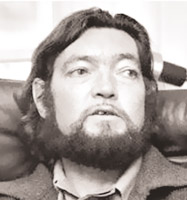
faces and tracesCortazar, Julio(An Argentinean Master of Antinovel and Experimental literature) [Archives:2008/1150/Culture]
April 28 2008
 |
Cortazar, Julio (1914-1984), Argentinean novelist, short-story writer, translator, and intellectual. Cortazar was born in Brussels, Belgium, to his Argentinean parents on August 26, 1914. Once World War I began, Cortazar's family forced to remain in Barcelona, Spain, for a year and a half. When Cortazar was four years old, his family returned to Argentina where he spent the rest of his childhood in Banfield, suburb of Buenos Aires. Cortazar attended the Escuela Normal de Profesores Mariano Acosta, a teachers training college and in 1935 he received a degree as a secondary-level teacher. Due to economic reasons, Cortazar was forced to discontinue his studies at University of Buenos Aires and begin teaching in remote provincial towns of Bol”var and Chivilcoy. From 1944 to 1945, Cortazar taught French literature at University of Cuyo in Mendoza. Then he joined a protest against Juan Peron, then President of Argentina, and was briefly imprisoned. Cortazar was a director for the publishing group Camara Argentina del Libro from 1946 to 1948 in Buenos Aires, completed a translation degree in record time, and worked as a public translator until the early 1950s. In 1951, in opposition to Peron's regime, Cortazar moved to Paris, France, where he worked for UNESCO as a freelance translator and divided the rest of his time moving between Paris and Saignon, town in northeastern France. Cortazar visited Cuba in 1961 and decided to assume his commitment to the struggle for liberation of Latin America. Consequently, he became a member of the Second Russell Tribunal for investigation of human rights abuses in Latin America. In 1975 Cortazar was a visiting lecturer at the University of Oklahoma and in 1980 he was a lecturer at Barnard College in New York. When the seven-year ban on his entry into Argentina was lifted, he visited his home country in 1983.
Cortazar belonged to the boom generation of Latin American writers who broke new ground with their works during the 1950s and 1960s. His literary career, which lasted almost 40 years, includes short stories, novels, plays, poetry, translations, and essays of literary criticism. His work is strongly influenced by surrealism with attempting to raise consciousness above reality in his fantastical short stories. He combined existential questioning with experimental writing techniques in his works and many of his stories follow the logic of hallucinations and obsessions.
Cortazar's first literary book, “Presencia” (Presence, 1938), was a collection of poetry that he published under the pseudonym Julio Den”s. One of his earliest poetic works, “Los Reyes” (The Kings, 1949), is a prose poem dealing with the legend of the Minotaur, the mythic Greek monster. “Bestiario” (Bestiary, 1951) is his first short-story collection which appeared in the review “The Annals of Buenos Aires”. The collection includes “Casa Tomada” (A House Taken Over) in which a middle-aged brother and sister find their house is invaded by unidentified people. In the title story a young girl senses that a tiger is roaming through her house. Cortazar published in 1956 the volume of short stories “Final del Juego” (End of the Game) which included the story “Los Venenos” (The Venoms) which he considers autobiographic. Other collections such as “Las Armas Secretas” (The Secret Weapons, 1959), “Todos Los Fuegos el Fuego” (All Fires the Fire, 1966), and “Someone Walking Around” (1977) contain many of the best examples of surrealist writing in postmodern literature. His story entitled “Las Babas del Diablo” was filmed under the title “Blow-Up” in 1966.
As a novelist, Cortazar gained first attention with “Los Premios” (The Winners, 1960) which centered on a group of people brought together when they win a mystery cruise in a lottery. Cortazar is most well known for the highly experimental novel entitled “Rayuela” (1963; Hopscotch, 1966). This masterpiece is an open-ended anti-novel in which the reader is invited to rearrange the material. The general idea behind “Hopscotch” is the proof of a failure and the hope of a victory. The novel was also intended to be a revolutionary novel by opening the door to linguistic innovation of Spanish language and influencing deeply Latin American writers. His novels “62: A Model Kit” (1968) and “Around the Day in 80 Worlds” (1986) became extensions of”Hopscotch”, yet other chapters which must be read and incorporated. The English version of “Hopscotch” won the 1967 United States National Book Award.
Cortazar also published poetry, drama, and various works of non-fiction. His book, “Libro de Manuel” (A Manual of Manuel, 1973), focused on the political condition of Latin America. “Cronopios and Famas” (1969) is an experimental literary collection of interconnected short pieces in which Cortazar incorporates elements of fiction, science, horror, and comedy into one work. His translation projects included Spanish renderings of Daniel Defoe's “Robinson Crusoe” and the stories of Edgar Alan Poe. One of his last works was a collaboration with his Canadian wife, Carol Dunlop, entitled “The Autonauts of the Cosmoroute” (1983) which related the couple's extended expedition from Paris to Marseilles in a Volkswagen.
In June 1981, the French government conceded him the French nationality. He also received numerous awards including Medicis Prize for Libro de Manuel in 1974 and Ruben Dar”o Order of Cultural Independence in 1983.
Cortazar passed away of leukemia and heart disease on February 12, 1984. Cortazar is a stunning Latin American writer who can induce the kind of chilling unease that strikes like a sound in the night. The renowned Chilean Nobel writer, Pablo Neruda, once said: “Anyone who doesn't read Cortazar is doomed.”
——
[archive-e:1150-v:18-y:2008-d:2008-04-28-p:culture]


